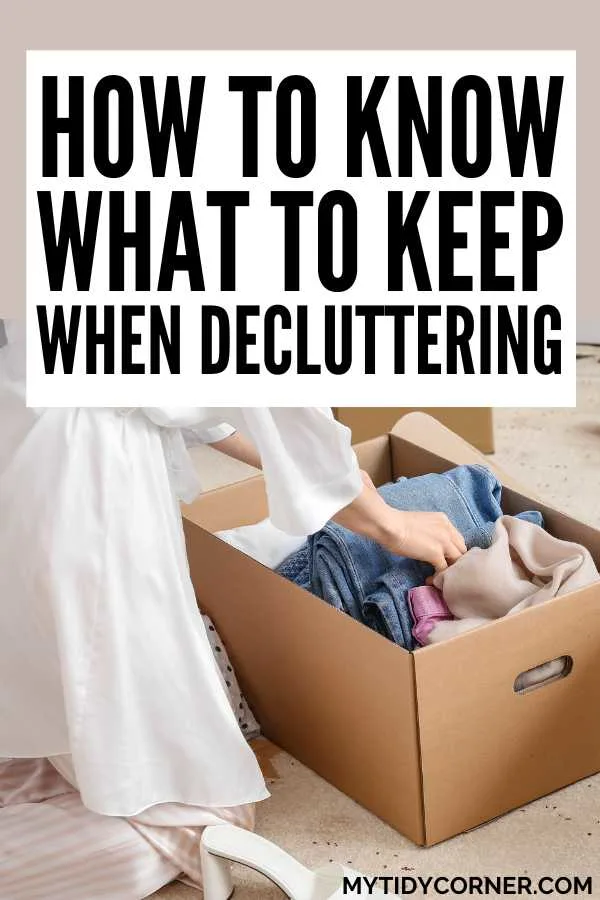Let’s talk about the elephant or should I say clutter in the room. If you are wondering how to decide what to keep when decluttering you are not alone.
We’ve all been there, staring at a mountain of items, wondering how in the world we amassed so much stuff. But here’s the twist: decluttering doesn’t have to be a tale of stark minimalism (unless that’s your style).
It’s more about creating your space to reflect a balance between aesthetics, functionality, and sentimentality. Trust me, I’ve walked the tightrope between “I might need this one day” and “Why do I still own this?”
So, how do you know what to keep when you’re knee-deep in decluttering mode?
When decluttering, keep items that bring you joy or have sentimental value. Items you use on a regular basis are also great keepers. Others include items that are in good condition or are repairable, and high quality item (costly to replace).

Step into the Role of a Curator as You Declutter
Imagine for a second that your home is a personal gallery. Everything within it should deserve its place, either because it serves you well, it brings you genuine happiness, or it’s just too beautiful to let go. So, pick up each item and ask yourself, “Does this belong in my life’s exhibit?” That’s your starting line.
3 Simple Tips on How to Know What to Keep When Decluttering
#1. Evaluating Necessity and Usage
When assessing item usage and necessity during the decluttering process, it’s important to take a systematic approach to determine which items are essential to keep and which can be let go of.
Frequency of Use: The Practical Workhorses
Here’s what I think: The stuff you use every day or even every week has earned its keep.
Seasonal Considerations: Calendar-Based Keepers
The holiday decor, that ski jacket, the coveted summer beach gear—they all have a place if you’re actively using them when the seasons roll around. Store them creatively during the off-season and bring them out when their time comes.
#2. Assessing Joy and Value
Determine if the item serves a critical function in your life or household.
Marie Kondo’s Spark of Joy: A Heartfelt Checklist
Marie Kondo says to keep items that spark joy. If picking up that kitschy mug from your road trip or snuggling into that well-worn sweater feels like a hug for your soul, they’re clear keepers.
Does that gadget you’ve never used or that impersonal gift from a distant cousin tug at your heartstrings? Yeah, didn’t think so.
Navigating Sentimentality vs. Practicality: The Balancing Act
Sentimental items are like emotional time capsules, right? We hold onto them because they transport us to cherished moments. A healthy dose of reality, though, can come in handy.
Distinguish what genuinely means the world to you from stuff that’s masquerading as sentimental. I still have a dress I inherited from my late mom (even though I don’t wear it) because it holds a great emotional value to me. The dress helps to keep alive the strong bond between my mom and I.
However, that’s only one dress – I have let go of almost all the other stuff I inherited from her because I don’t need or use them.
#3. Looking at Quality and Condition
Keep items that contribute positively to your daily routine.
Best of the Bunch: If You Were on a Desert Island…
A mental game I play is the desert island scenario. If I were stranded with a limited choice of personal belongings, would this make the cut? The one blender that you swear makes your smoothies perfectly? That’s a keeper. But the shoddy one that screeches and smells vaguely of smoke? You can part with one another.
Repairable vs. End-of-Life: Be Real
I’m all for giving worthy items a second lease on life with a good repair, but let’s call it: some things are just beyond saving. Examine each object. Will repairing it be cost-efficient and extend its life significantly? If yes, keep it. If it’s on its last legs, thank it for its service and bid farewell.
More Tips to Help You Determine What Items to Keep
Mastering the Keep-or-Toss Game
Alright, now that we’ve covered the criteria for making those tricky keep-or-toss decisions, here are more tips that will help you in your decluttering journey.
Tackling the “Just in Case” Syndrome
I get it—the fear of needing something the minute after you toss it is real. But let’s put things in perspective: How easy is it to borrow or replace it if that rare need arises? Let practicality guide you, and remind yourself that space is a luxury.
Relishing in the “Less is More” Space
When you let go of excess, your living space breathes better. And so do you. With fewer items to manage, you can focus on those that truly add value to your life. And let’s not kid ourselves—fewer belongings mean less cleaning time, and that, my friends, is the ultimate win.
Embracing the Change: Keep, Swap, Evolve
Remember that change is the only constant. Give yourself permission to switch things up. Swap stuff with friends, repurpose items, or boldly decide you no longer need what once seemed indispensable. Your space should evolve with you.
Experimenting with Storage Solutions
Once you’ve narrowed down your keepers, get crafty with storage solutions that are as chic as they are clever. Floating shelves, under-bed boxes, clever hooks—your options are aplenty. Challenge yourself to create a space that is functional, beautiful, and true to your personal taste.
Final Thoughts on Deciding What to Keep When Decluttering
Consider this: Every item you decide to keep is a vote for the kind of room you want to live in (the kind of daily life you wish to lead). So handle each piece kindly but decisively. And don’t stress if you get it wrong, there’s always next time.
Your environment should serve as a canvas for your life, displaying your story, housing your joys, and facilitating your adventures. Treat it with care, fill it with intention, and above all, ensure it’s a reflection of who you are, not just a receptacle for possessions.
Decluttering is an ongoing process—a dialogue with your past and present selves. So, as you sift through the physical embodiment of memories, souvenirs, and tools for living, keep a discerning eye and an open heart. Remember, your best space is one that allows you to live your best life.
Related Decluttering Articles:
- 13 Questions to Ask Yourself When Decluttering
- A Beginner’s Guide to Decluttering
- List of 60+ Items You Can Get Rid Of

